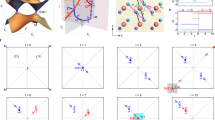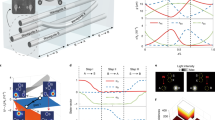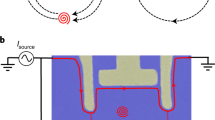Abstract
Non-Abelian braiding is regarded as an essential process for realizing quantum logic. Its realizations in quantum systems often rely on the dynamic winding of anyons, which can be challenging to obtain. Implementing braiding in a classical system could, therefore, assist the experimental study of non-Abelian physics. Here we present the realization of the non-Abelian braiding of multiple degenerate acoustic waveguide modes. The dynamics of non-Abelian braiding can be captured by the non-Abelian Berry–Wilczek–Zee phase that connects the holonomic adiabatic evolutions of multiple degenerate states. The cyclic evolution of degenerate states induces a non-Abelian geometric phase, manifesting as the exchange of states. The non-Abelian characteristics are revealed by switching the order of two distinct braiding processes involving three modes. Our work demonstrates wave manipulations based on non-Abelian braiding and logic operations.
This is a preview of subscription content, access via your institution
Access options
Access Nature and 54 other Nature Portfolio journals
Get Nature+, our best-value online-access subscription
$29.99 / 30 days
cancel any time
Subscribe to this journal
Receive 12 print issues and online access
$209.00 per year
only $17.42 per issue
Buy this article
- Purchase on Springer Link
- Instant access to full article PDF
Prices may be subject to local taxes which are calculated during checkout




Similar content being viewed by others
Data availability
Source data are provided with this paper. All other data that support the plots within this paper and other findings of this study are available from the corresponding author upon reasonable request.
References
Tsui, D. C., Stormer, H. L. & Gossard, A. C. Two-dimensional magnetotransport in the extreme quantum limit. Phys. Rev. Lett. 48, 1559–1562 (1982).
Halperin, B. I. Statistics of quasiparticles and the hierarchy of fractional quantized Hall states. Phys. Rev. Lett. 52, 1583–1586 (1984).
Arovas, D., Schrieffer, J. R. & Wilczek, F. Fractional statistics and the quantum Hall effect. Phys. Rev. Lett. 53, 722–723 (1984).
Stern, A. Non-Abelian states of matter. Nature 464, 187–193 (2010).
Stern, A. Anyons and the quantum Hall effect—a pedagogical review. Ann. Phys. 323, 204–249 (2008).
Das Sarma, S., Freedman, M. & Nayak, C. Topologically protected qubits from a possible non-Abelian fractional quantum Hall state. Phys. Rev. Lett. 94, 166802 (2005).
Freedman, M., Nayak, C. & Walker, K. Towards universal topological quantum computation in the ν = 5/2 fractional quantum Hall state. Phys. Rev. B 73, 245307 (2006).
Wen, X. G. Non-Abelian statistics in the fractional quantum Hall states. Phys. Rev. Lett. 66, 802–805 (1991).
Moore, G. & Read, N. Nonabelions in the fractional quantum hall effect. Nucl. Phys. B 360, 362–396 (1991).
Ivanov, D. A. Non-Abelian statistics of half-quantum vortices in p-wave superconductors. Phys. Rev. Lett. 86, 268–271 (2001).
Alicea, J. New directions in the pursuit of Majorana fermions in solid state systems. Rep. Prog. Phys. 75, 076501 (2012).
Lutchyn, R. M., Sau, J. D. & Das Sarma, S. Majorana fermions and a topological phase transition in semiconductor-superconductor heterostructures. Phys. Rev. Lett. 105, 077001 (2010).
Sau, J. D., Lutchyn, R. M., Tewari, S. & Das Sarma, S. Generic new platform for topological quantum computation using semiconductor heterostructures. Phys. Rev. Lett. 104, 040502 (2010).
Berry, M. V. Quantal phase factors accompanying adiabatic changes. Proc. R. Soc. Lond. A 392, 45–57 (1984).
Wilczek, F. & Zee, A. Appearance of gauge structure in simple dynamical systems. Phys. Rev. Lett. 52, 2111–2114 (1984).
Zanardi, P. & Rasetti, M. Holonomic quantum computation. Phys. Lett. A 264, 94–99 (1999).
Duan, L.-M. Geometric manipulation of trapped ions for quantum computation. Science 292, 1695–1697 (2001).
Abdumalikov, A. A. Jr et al. Experimental realization of non-Abelian non-adiabatic geometric gates. Nature 496, 482–485 (2013).
Simon, B. Holonomy, the quantum adiabatic theorem, and Berry’s phase. Phys. Rev. Lett. 51, 2167–2170 (1983).
Tomita, A. & Chiao, R. Y. Observation of Berry’s topological phase by use of an optical fiber. Phys. Rev. Lett. 57, 937–940 (1986).
Shapere, A. & Wilczek, F. Geometric Phases in Physics (World Scientific, 1989).
Chruscinski, D. & Jamiolkowski, A. Geometric Phases in Classical and Quantum Mechanics (Birkhäuser, 2004).
Cohen, E. et al. Geometric phase from Aharonov–Bohm to Pancharatnam–Berry and beyond. Nat. Rev. Phys. 1, 437–449 (2019).
Yang, Y. et al. Synthesis and observation of non-Abelian gauge fields in real space. Science 365, 1021–1025 (2019).
Kremer, M., Teuber, L., Szameit, A. & Scheel, S. Optimal design strategy for non-Abelian geometric phases using Abelian gauge fields based on quantum metric. Phys. Rev. Res. 1, 033117 (2019).
Chen, Y. et al. Non-Abelian gauge field optics. Nat. Commun. 10, 3125 (2019).
Noh, J. et al. Braiding photonic topological zero modes. Nat. Phys. 16, 989–993 (2020).
Bomzon, Z., Biener, G., Kleiner, V. & Hasman, E. Space-variant Pancharatnam–Berry phase optical elements with computer-generated subwavelength gratings. Opt. Lett. 27, 1141–1143 (2002).
Bomzon, Z., Kleiner, V. & Hasman, E. Pancharatnam–Berry phase in space-variant polarization-state manipulations with subwavelength gratings. Opt. Lett. 26, 1424–1426 (2001).
Hasman, E., Kleiner, V., Biener, G. & Niv, A. Polarization dependent focusing lens by use of quantized Pancharatnam–Berry phase diffractive optics. Appl. Phys. Lett. 82, 328–330 (2003).
Li, G. et al. Continuous control of the nonlinearity phase for harmonic generations. Nat. Mater. 14, 607–612 (2015).
Tymchenko, M. et al. Gradient nonlinear Pancharatnam-Berry metasurfaces. Phys. Rev. Lett. 115, 207403 (2015).
Wang, S., Ma, G. & Chan, C. T. Topological transport of sound mediated by spin-redirection geometric phase. Sci. Adv. 4, eaaq1475 (2018).
Iadecola, T., Schuster, T. & Chamon, C. Non-Abelian braiding of light. Phys. Rev. Lett. 117, 073901 (2016).
Boross, P., Asbóth, J. K., Széchenyi, G., Oroszlány, L. & Pályi, A. Poor man’s topological quantum gate based on the Su-Schrieffer-Heeger model. Phys. Rev. B 100, 045414 (2019).
Wu, Y., Liu, H., Liu, J., Jiang, H. & Xie, X. C. Double-frequency Aharonov-Bohm effect and non-Abelian braiding properties of Jackiw-Rebbi zero-mode. Natl Sci. Rev. 7, 572–578 (2020).
Barlas, Y. & Prodan, E. Topological braiding of non-Abelian midgap defects in classical metamaterials. Phys. Rev. Lett. 124, 146801 (2020).
Niemi, A. J. & Semenoff, G. W. Fermion number fractionization in quantum field theory. Phys. Rep. 135, 99–193 (1986).
Chen, Z.-G., Wang, L., Zhang, G. & Ma, G. Chiral symmetry breaking of tight-binding models in coupled acoustic-cavity systems. Phys. Rev. Appl. 14, 024023 (2020).
Chen, Z.-G., Tang, W., Zhang, R.-Y., Chen, Z. & Ma, G. Landau-Zener transition in the dynamic transfer of acoustic topological states. Phys. Rev. Lett. 126, 054301 (2021).
Pozar, D. M. Microwave Engineering 4th edn (Wiley, 2011).
Zhang, Y.-L., Chen, Q.-D., Xia, H. & Sun, H.-B. Designable 3D nanofabrication by femtosecond laser direct writing. Nano Today 5, 435–448 (2010).
Acknowledgements
Z.-G.C. and G.M. thank W. Tang and Q. Wang for experimental assistance. This work was supported by Hong Kong Research Grants Council (12302420, 12300419, 22302718, C6013-18G, AoE/P-02/12 and 16303119), National Natural Science Foundation of China (11922416 and 11802256) and Hong Kong Baptist University (RC-SGT2/18-19/SCI/006). R.-Y.Z. and C.T.C. also acknowledge support from the Croucher Foundation (CAS20SC01).
Author information
Authors and Affiliations
Contributions
Z.-G.C. and R.-Y.Z. developed the theory. Z.-G.C. performed the numerical simulations. Z.-G.C. and G.M. carried out the experiments with support from C.T.C. All the authors analysed the results. Z.-G.C. and G.M. wrote the manuscript with inputs from R.-Y.Z. and C.T.C. The project was initiated and supervised by G.M.
Corresponding author
Ethics declarations
Competing interests
The authors declare no competing interests.
Additional information
Peer review information Nature Physics thanks the anonymous reviewers for their contribution to the peer review of this work.
Publisher’s note Springer Nature remains neutral with regard to jurisdictional claims in published maps and institutional affiliations.
Supplementary information
Supplementary Information
Supplementary Figs. 1–12.
Source data
Source Data Fig. 2
Statistical source data.
Source Data Fig. 4
Statistical source data.
Rights and permissions
About this article
Cite this article
Chen, ZG., Zhang, RY., Chan, C.T. et al. Classical non-Abelian braiding of acoustic modes. Nat. Phys. 18, 179–184 (2022). https://doi.org/10.1038/s41567-021-01431-9
Received:
Accepted:
Published:
Issue Date:
DOI: https://doi.org/10.1038/s41567-021-01431-9
This article is cited by
-
Robust temporal adiabatic passage with perfect frequency conversion between detuned acoustic cavities
Nature Communications (2024)
-
Revealing topology in metals using experimental protocols inspired by K-theory
Nature Communications (2023)
-
A second wave of topological phenomena in photonics and acoustics
Nature (2023)
-
Ideal acoustic quantum spin Hall phase in a multi-topology platform
Nature Communications (2023)
-
Making weaves
Nature Physics (2022)



